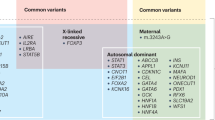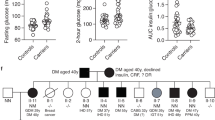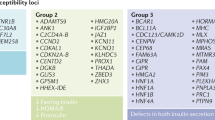Abstract
THE disease maturity-onset diabetes of the young (MODY) is a genetically heterogeneous monogenic form of non-insulin-dependent (type 2) diabetes mellitus (NIDDM), characterized by early onset, usually before 25 years of age and often in adolescence or childhood, and by autosomal dominant inheritance1. It has been estimated that 2–5% of patients with NIDDM may have this form of diabetes mellitus2,3. Clinical studies have shown that predia-betic MODY subjects have normal insulin sensitivity but suffer from a defect in glucose-stimulated insulin secretion, suggesting that pancreatic β-cell dysfunction rather than insulin resistance is the primary defect in this disorder4,5. Linkage studies have localized the genes that are mutated in MODY on human chromosomes 20 (MODY1)6, 7 (MODY2)2 and 12 (MODY3}7, with MODY2 and MODY3 being allelic with the genes encoding glucokinase2, a key regulator of insulin secretion, and hepatocyte nuclear factor-1α (HNF-1α)8, a transcription factor involved in tissue-specific regulation of liver genes but also expressed in pancreatic islets, insulinoma cells and other tissues. Here we show that MODY1 is the gene encoding HNF-4α (gene symbol, TCP14), a member of the steroid/thyroid hormone receptor superfamily and an upstream regulator of HNF-1α expression9–11.
This is a preview of subscription content, access via your institution
Access options
Subscribe to this journal
Receive 51 print issues and online access
$199.00 per year
only $3.90 per issue
Buy this article
- Purchase on Springer Link
- Instant access to full article PDF
Prices may be subject to local taxes which are calculated during checkout
Similar content being viewed by others
References
Fajans, S. S. Diab./Metabol. Rev. 5, 579–606 (1989).
Froguel, P. et al. N. Engl. J. Med. 328, 697–702 (1993).
Ledermann, H. M. Lancet 345, 648 (1995).
Herman, W. H. et al. Diabetes 43, 40–46 (1994) [erratum, Diabetes 43, 1171 (1994)].
Byrne, M. M. et al. Diabetes 44, 699–704 (1995).
Bell, G. I. et al. Proc. Natl Acad. Sci. USA 88, 1484–1488 (1991).
Vaxillaire, M. et al. Nature Genet. 9, 418–423 (1995).
Yamagata, K. et al. Nature 384, 455–458 (1996).
Sladek, F. M., Zhong, W., Lai, E. & Darnell, J. E. Jr Genes Dev. 4, 2353–2365 (1990).
Kuo, C. J. et al. Nature 355, 457–461 (1992).
Mangelsdorf, D. J. et al. Cell 83, 835–839 (1995).
Fajans, S. S., Bell, G. I., Bowden, D. W., Halter, J. B. & Polonsky, K. S. Life Sci. 55, 413–422 (1994).
Irwin, M., Cox, N. & Kong, A. Proc. Natl Acad. Sci. USA 91, 11684–11688 (1994).
Stoffel, M. et al. Proc. Natl Acad. Sci. USA 93, 3939–3941 (1996).
Chartier, F. L., Bossu, J.-P., Laudet, V., Fruchart, J.-C. & Laine, B. Gene 147, 269–272 (1994).
Xanthopoulos, K. G. et al. Proc. Natl Acad. Sci. USA 88, 3807–3811 (1991).
Miquerol, L. et al. J. Biol. Chem. 269, 8944–8951 (1994).
Chen, W. S. et al. Genes Dev. 8, 2466–2477 (1994).
Emens, L. A., Landers, D. W. & Moss, L. G. Proc. Natl Acad. Sci. USA 89, 7300–7304 (1992).
Zhang, X.-K., Salbert, G., Lee, M.-O. & Pfahl, M. Mol. Cell. Biol. 14, 4311–4323 (1994).
Bourguet, W., Ruff, M., Chambon, P., Gronemeyer, H. & Moras, D. Nature 375, 377–382 (1995).
Renaud, J.-P. et al. Nature 378, 681–689 (1995).
Wagner, R. L. et al. Nature 378, 690–697 (1995).
Byrne, M. M. et al. Diabetes 45, 1503–1510 (1996).
Hanis, C. L. et al. Nature Genet. 13, 161–166 (1996).
Iwasaki, N. et al. J. Japan. Diab. Soc. 39, 409–416 (1996).
Polonsky, K. S., Sturis, J. & Bell, G. I. N. Engl. J. Med. 334, 777–783 (1996).
Drewes, T., Senkel, S., Holewa, B. & Ryffel, G. U. Mol. Cell. Biol. 16, 925–931 (1996).
Tavaviras, S., Monaghan, A. P., Schütz, G. & Kelsey, G. Mech. Dev. 48, 67–79 (1994).
Author information
Authors and Affiliations
Rights and permissions
About this article
Cite this article
Yamagata, K., Furuta, H., Oda, N. et al. Mutations in the hepatocyte nuclear factor-4α gene in maturity-onset diabetes of the young (MODY1). Nature 384, 458–460 (1996). https://doi.org/10.1038/384458a0
Received:
Accepted:
Issue Date:
DOI: https://doi.org/10.1038/384458a0
This article is cited by
-
The autophagy protein Def8 is altered in Alzheimer's disease and Aβ42-expressing Drosophila brains
Scientific Reports (2023)
-
Monogenic diabetes
Nature Reviews Disease Primers (2023)
-
De novo HNF4A-associated atypical Fanconi renal tubulopathy syndrome
Journal of Nephrology (2023)
-
Targeted Activation of HNF4α by AMPK Inhibits Apoptosis and Ameliorates Neurological Injury Caused by Cardiac Arrest in Rats
Neurochemical Research (2023)
-
Reflections on the state of diabetes research and prospects for treatment
Diabetology International (2023)
Comments
By submitting a comment you agree to abide by our Terms and Community Guidelines. If you find something abusive or that does not comply with our terms or guidelines please flag it as inappropriate.



